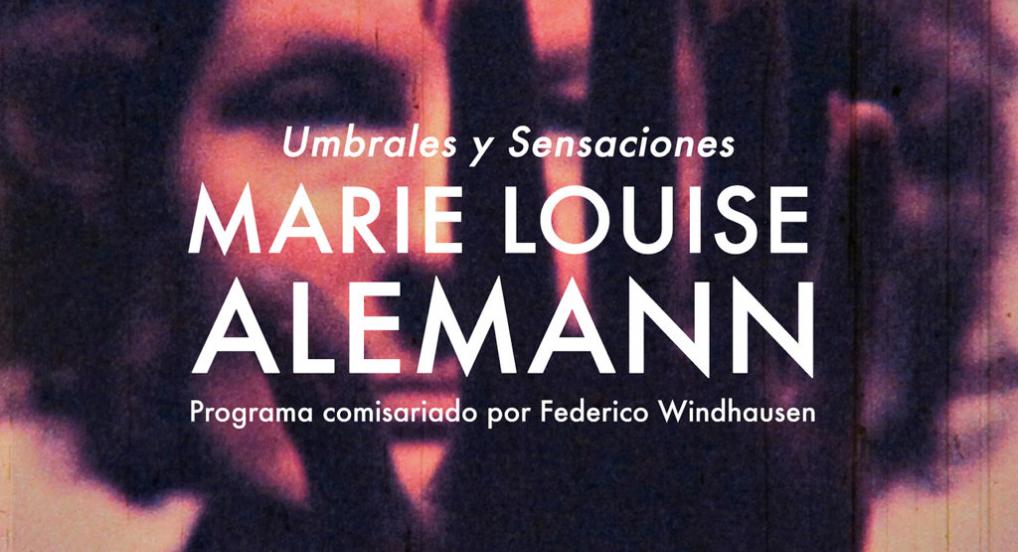Marie Louise Alemann (North Rhine-Westphalia, 1927 - Buenos Aires, 2015) was a pioneer filmmaker of Argentine experimental cinema. Between the seventies and eighties, she teamed up with fellow filmmakers such as Narcisa Hirsch, Claudio Caldini and Juan José Mugni, among others, and played an important role in the promotion of experimental cinema in Buenos Aires.
Alemann was born in 1927 in North Rhine-Westphalia, Germany. As a result of the Second World War, she fled to Czechoslovakia, from where she left to reach Buenos Aires in 1949, the city where she settled. Her activity was oriented towards different fields, such as photography, performance and cultural journalism. Alemann traveled often, working as a journalist and film critic or simply pursuing her cosmopolitan interests. With her friend émigré Narcisa Hirsch found in the 60s in Buenos Aires an "underground" culture that inspired her to start her own artistic practices and soon to build a less traditional life. Provoked also by experimental film movements from other parts of the world, Alemann began making her version of that cinema, usually using the Super 8 format not only because it was cheap and portable but also because of its aesthetic capabilities.
During some of the most active years of her own cinematographic explorations - of the dynamics between the body and the camera, the destabilizing effects of the experimental sound and the psychological impacts of repressive regimes of various types - Alemann also promoted, together with Hirsch, the Argentine and international experimental cinema at the headquarters of the Goethe Institute of Buenos Aires. Within the Institute it was possible not only to present generally despised films within the film cultures of the time but also to encourage public debate, to organize contests with prizes for filmmakers working with super 8 and to offer workshops with figures such as Werner Nekes and Werner Schroeter. –Federico Windhausen
Thresholds and Sensations: The cinema of Marie Louise Alemann
From the late sixties to the mid-eighties Marie Louise Alemann (1927-2015) made short films that are distinguished by their performative explorations and their striking images of faces, bodies and objects, filmed with a visual style that alternates between the decorative and the minimalist. Always looking for an unexpected emotional impact, in her shorts Alemann presents herself and her friends in urban and rural spaces, with strange accessories and costumes, in scenes of sometimes eccentric symbolism, sometimes simple and openly decipherable. Even when she translates into the cinema the most elusive and enigmatic dimensions of her subjective experience, Alemann seeks to generate a special connection with the viewer. –Federico Windhausen
"I'm used to doing everything by myself, with a very small group of people. I do everything, the editing, the music, the sound. It is one of the advantages of the Super 8, but it is also a disadvantage. It allows greater freedom but reduces the possibility of reaching a mass audience .... The kind of cinema that I do can not be studied, you learn by doing it. The intention is to show your own inner images and hope that they have something in common with those of another person. You have to achieve the synthesis of something that everyone feels and turn it into an image. It's like a learning process. One sees that image and connects with the thought that is behind that image. That's why my cinema is experimental, for me it's getting things out of me. Almost all my films are, in a way, autobiographical, they all have to do with me. " (Alemann, 1979)
“I am a filmmaker because I live through my eyes. I speak much more easily through the images. I do not speak much. I like to make very short films so that the subject is very concentrated and remains in the memory of the spectators .... My desire and enjoy filming goes through the Super 8. The other formats do not interest me.” (Alemann to Gérard Courant,1980)
- Untitled (1975) super 8, color, silent, 5.5 min. (a film by Juan José Mugni)
- Vanessa (1974) super 8, color, silent, 6 min.
- Autobiografico 2 (1974) super 8, color, silent, 5 min. (camara Narcisa Hirsch)
- Escenas de mesa (1979) super 8 to VHS**, color, sound, 8 min.
- Sensación 77: Mimetismo (1977) super 8 to VHS**, color, sound, 8 min. (camara Claudio Caldini)
- Legitima defensa (1980) super 8, color, sound, 8 min. (camara Claudio Caldini)
- Umbrales (1980) super 8, color, sound, 19 min.
*Screening introduced by Federico Windhausen and conducted by Andrea Franco
Screening format: HD / **SD
Special thanks to Federico Windhausen, Andrea Franco and (S8) Mostra de Cinema Periférico

